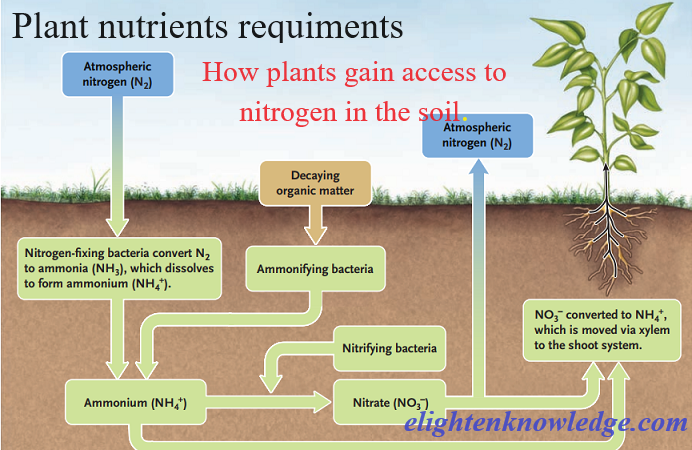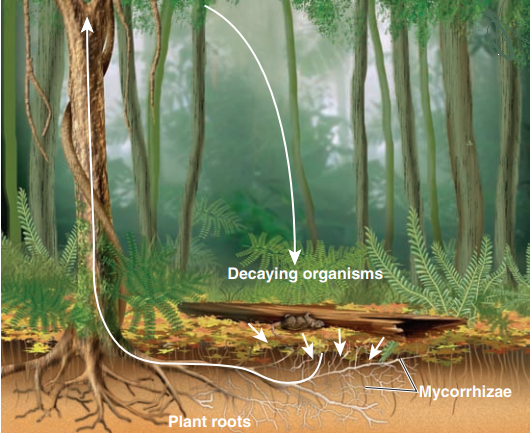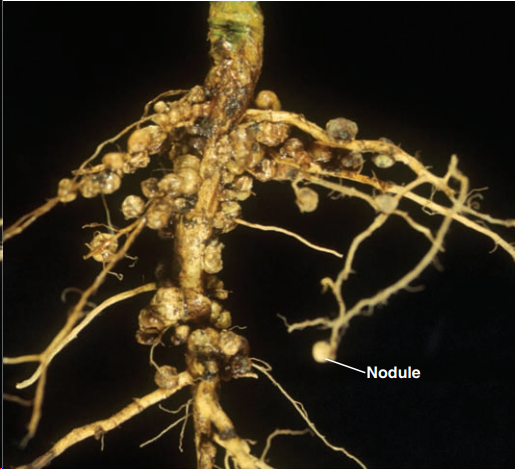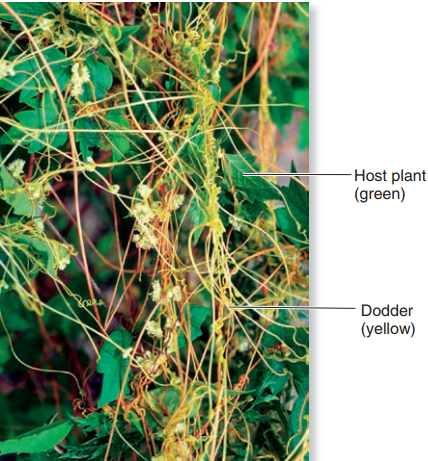Plant Nutritional Requirement Note; Elective biology for SHS.

Plant nutritional requirement
Introduction.
Plants are unique organisms that can absorb nutrients and water through their root system and carbon dioxide from the atmosphere.
Soil quality and climate are the major determinants of plant distribution and growth.
The combination of soil nutrients, water, carbon dioxide, and sunlight allow plants to grow.
The majority of volume in a plant cell is water; it typically comprises 80 to 90 percent of the plant’s total weight.
Soil is the water source for land plants, and can be an abundant source of water, even if it appears dry.
Plant roots absorb water from the soil through root hairs and transport it up to the leaves through the xylem.
As water vapor is lost from the leaves, the process of transpiration and the polarity of water molecules (which enables them to form hydrogen bonds) draws more water from the roots up through the plant to the leaves
Plants need water to support cell structure, for metabolic functions, to carry nutrients, and for photosynthesis.
Plant cells need essential substances, collectively called nutrients, to sustain life.
Plant nutrients may be composed of either organic or inorganic compounds.
An organic compound is a chemical compound that contains carbon, such as carbon dioxide obtained from the atmosphere.
Carbon that was obtained from atmospheric CO2 composes the majority of the dry mass within most plants.
An inorganic compound does not contain carbon and is not part of, or produced by, a living organism.
Inorganic substances, which form the majority of the soil solution, are commonly called minerals.
A mineral is an inorganic substance usually containing two or more elements.
Essential Nutrients
Plants require only light, water, and about 20 elements to support all their biochemical needs: these 20 elements are called essential nutrients.
A plant nutrient is said to be an essential nutrient when,
- It has an identifiable role,
- No other nutrient can substitute and fulfil the same role
- A deficiency of this nutrient causes a plant to die without completing its life cycle.
- The element is directly involved in plant nutrition.
Essential nutrients are divided into macronutrients and micronutrients according to their relative concentrations in plant tissue.
Macronutrients
Macronutrients are the nutrients that plants require in larger amounts for proper growth and development.
About half of the essential elements are considered macronutrients and these are
-
- carbon,
- hydrogen,
- oxygen,
- nitrogen,
- phosphorus,
- potassium,
- calcium,
- magnesium
- Sulphur
Carbon (C) is required to form carbohydrates, proteins, nucleic acids, and many other compounds
It is therefore present in all macromolecules.
On average, a cell’s dry weight (excluding water) is 50 percent carbon.
The next most abundant element in plant cells is nitrogen (N)
It is part of proteins and nucleic acids.
Nitrogen is also used in the synthesis of some vitamins.
Hydrogen and oxygen are macronutrients that are part of many organic compounds and also form water.
Oxygen is necessary for cellular respiration;
Plants use oxygen to store energy in the form of ATP.
Phosphorus (P), another macromolecule, is necessary to synthesize nucleic acids and phospholipids.
As part of ATP, phosphorus enables food energy to be converted into chemical energy through oxidative phosphorylation.
Likewise, light energy is converted into chemical energy during photophosphorylation in photosynthesis, and into chemical energy to be extracted during respiration.
Sulphur is part of certain amino acids, such as cysteine and methionine, and is present in several coenzymes.
Sulphur also plays a role in photosynthesis as part of the electron transport chain, where hydrogen gradients play a key role in the conversion of light energy into ATP.
Potassium (K) is important because of its role in regulating stomatal opening and closing.
As the openings for gas exchange
Stomata help maintain a healthy water balance
A potassium ion pump supports this process.
Magnesium (Mg) and calcium (Ca) are also important macronutrients.
Calcium regulates nutrient transport and supports many enzyme functions.
Magnesium is important to the photosynthetic process.

Micronutrients.
They are also known as trace elements/nutrients.
Micronutrients are nutrients needed in very small quantities for plant growth and development.
They include;
-
- Boron (B),
- Chlorine (Cl),
- Manganese (Mn),
- iron Fe),
- zinc (Zn),
- Copper (Cu),
- Molybdenum (Mo),
- Nickel (Ni),
- Silicon (Si),
- Sodium (Na).
Hydroponics
Hydroponics is a method of growing plants in a water culture (water-nutrient solution) instead of soil.
It has developed into a growing process that researchers often use.
Scientists who are interested in studying plant nutrient deficiencies can use hydroponics to study the effects of different nutrient combinations under strictly controlled conditions.
Hydroponics has also developed as a way to grow flowers, vegetables, and other crops in greenhouse environments.
Currently, many lettuces and tomatoes in the market have been hydroponically grown.
Essential Plant Nutrients and Their Functions
|
Elements |
Form in which they are absorbed. | Major functions |
Deficiency symptoms. |
|
MACRONUTRIENTS |
|||
|
Nitrogen |
NO3– NH4+ |
· It forms part of the nucleic acids.
· It forms part of proteins · It also forms part of the chlorophyll. · It forms part of coenzymes. |
· Stunted growth with small leaves.
· Chlorosis (yellowing of leaves. |
|
Potassium |
K+ |
· It serves as a cofactor for enzymes.
· Water balancing. · Opening of stomata
|
· Leave may show signs of chlorosis.
· Matured leaves affected become mottled with dead sport along the margin. |
|
Phosphorus |
H2PO4– HPO42- |
· Form part of nucleic acids.
· Form part of ATP. · Form part phospholipids. |
· Stunted growth.
· Purple leaves sometimes. |
|
Sulphur |
SO42- |
· It forms part of amino acids.
· It also forms part of some coenzymes. |
· Poor root growth.
· Yellowing of new leave. · Improper stem growth. |
|
Calcium |
Ca2+ |
· Regulates responses to stimuli.
· It also regulates the movement of substances through the plasma membrane · Involved in the formation and stability of cell |
· Stunted growth.
· Poor root growth and development. |
|
Magnesium |
Mg2+ |
· Forms part of chlorophyll.
· Activates several enzymes. |
· Poor general growth and development of plants.
· Chlorosis. |
Micronutrients and their functions
|
Micronutrients |
||
|
Elements |
Form in which they are absorbed. |
Major functions |
|
Chlorine (Cl) |
Cl– |
· Required for water splitting in photosystem.
· Cell ion balance |
|
Manganese (Mn) |
Mn2+ |
· As enzyme cofactor |
|
Sodium (Na) |
Na+ |
· Required to generate PEP in C4 and CAM plants |
|
Molybdenum (Mo) |
MoO42- |
· As enzyme cofactor. |
|
Copper (Cu) |
Cu+ Cu2+ |
· As enzyme cofactor. |
|
Nickel (Ni) |
Ni2+ |
· As enzyme cofactor. |
|
Zinc (Zn) |
Zn2+ |
· As enzyme cofactor. |
|
Boron (B) |
B(OH)3 |
· As enzyme cofactor.
· As a component of cell walls. |
|
Iron (Fe) |
Fe3+ Fe2+ |
· Enzyme cofactor.
· component of cytochromes. |
- PEP stands for phosphoenolpyruvate
- CAM stands for crassulacean acid metabolism.
Mycorrhizal Associations Help Most Plants Obtain Mineral Nutrients
‘Myco’ means fungi and ‘rhiza’ means root, therefore the term means fungi roots
At least 80% of seed plants have symbiotic associations with fungi that live within the tissues of plant roots or that envelop root surfaces. These associations are termed mycorrhizae.
In mycorrhizal associations, soil fungi obtain organic food from the roots of photosynthetic plant hosts, and the fungi supply the plants with water and mineral nutrients.
Due to the extensive mycelia that fungi produce within the soil, these fungus root associations provide an exceptionally efficient way for plants to harvest water and minerals, especially phosphate, from a much larger volume of soil than is available to roots by themselves.
The presence of lush vegetation on thin, infertile tropical rainforest soils is largely due to the ability of mycorrhizae to rapidly absorb mineral nutrients released by decaying organisms and transmit the nutrients directly to plant roots.

Certain plants benefit from a symbiotic relationship with bacteria that results in the fixing of nitrogen.
Soils contain large populations of thousands of bacterial species, many of which aid plant growth.
Some soil bacteria produce plant hormones that affect root structure, others help plants tolerate drought and other stresses, and some provide plants with nutrients, notably fixed nitrogen.
In nitrogen-fixation symbioses, the plants provide organic nutrients to the bacteria, and the bacteria supply the plants with a much higher supply of fixed nitrogen than the plants could obtain from most soils.
Representatives of three types of nitrogen-fixing bacteria (cyanobacteria, actinobacteria, and proteobacteria) are symbiotically associated with specific types of plants.
Plant-Cyanobacteria Symbioses
- Although most cyanobacteria are themselves photosynthetic, organic compounds supplied by plant partners subsidize the high energy costs of nitrogen fixation.
- This allows the cyanobacteria to fix more nitrogen than they require, secreting the excess to plant partners. Nitrogen-fixing cyanobacteria form symbioses with some bryophytes, ferns, and gymnosperms, as well as the flowering plant Gunnera.
- This plant is commonly known as the giant rhubarb or prickly rhubarb.
- Nitrogen-fixing symbionts are advantageous to Gunnera because this large plant grows in nitrogen-poor habitats, such as volcanic slopes.
- Gunnera harbours cyanobacteria within stems and leaf petioles.
- In these locations, the cyanobacteria can use cyclic electron flow to transform light energy into ATP, needed to produce fixed nitrogen.
- The presence of nitrogen-fixing cyanobacteria helps to explain why Gunnera can grow to dramatic size on poor soils.
Woody Plant–Actinobacteria Symbioses
- In contrast to cyanobacteria, actinobacteria are heterotrophic nitrogen-fixing bacteria.
- Actinobacteria known as Frankia occur in nodules formed on the underground roots of certain shrubs or trees, such as alder (Alnus) and myrtle (Myrica).
- These plants receive fixed nitrogen from their bacterial partners, which, in turn, obtain organic nutrients.
- Woody plants, such as Ceanothus shrubs, that have Frankia symbionts are able to grow abundantly even in places where soil nitrogen is low.
Legume-Rhizobia Symbioses
- The nitrogen-fixation symbioses most important in nature and to agriculture involve certain proteobacteria that are collectively known as rhizobia (from the Greek rhiza, meaning root).
- Rhizobia live within root cells of wild and cultivated legumes, forming legume-rhizobia symbioses.
- In nature, legume plants are important sources of fixed nitrogen for other plants.
- When legumes die, they generate soil organic matter that is enriched with fixed nitrogen.
- Consequently, wild legumes are regarded as particularly valuable members of natural plant communities.
- Important legume crops include soybeans, peas, beans, peanuts, clover, and alfalfa.
- Foods produced from soybeans, peas, beans, and pea-nuts are valued for their high protein content.
- Clover and alfalfa are used for animal food and to enrich fields with the fixed nitrogen needed by subsequent food crops.
- The value of these crops arises from their fixed- nitrogen content.
- The amount of ammonia produced by legume-rhizobia symbioses nearly equals the world’s entire industrial production.

Carnivorous plants obtain mineral nutrients from the digested bodies of trapped animals. Examples are;
- Venus flytrap (Dionaea muscipula)
- Pitcher plant (genus Nepenthes)
- Sundews (such as Drosera rotundifolia)
Parasitic plants obtain water, mineral ions, and organic compounds from green plant hosts.
Examples;
- Dodder (Cuscuta pentagona) lacks roots and does not grow from the soil.
- These parasites twine their yellow or orange stems around green plant hosts, into which they sink peg-shaped, absorptive structures known as haustoria.
- These haustoria tap into the host plant’s vascular system, gaining water, minerals, and sugar, which the parasite uses for growth and reproduction.
- The long, flexible stems of the dodder often loop from one plant to another, allowing an individual dodder plant to tap into many different host plants at the same time.
- Dodder reproduces very rapidly by means of broken-off stem fragments and seeds.
- In consequence, dodder is a widespread agricultural pest that attacks citrus, tomatoes, and many other fruit, vegetable, forage, and flower crops.
- Another group of parasitic plants, the witchweeds (genus Striga), are serious problems for agriculture worldwide because these parasites attack major cereal crops: corn, sorghum, rice, and millet.
- Witchweed seeds lie dormant in soil until secretions from host plant roots stimulate their germination.
- Genetic engineers are working to find ways to protect crops from the debilitating effects of these crop parasites.






